(→Biomas fríos: varias traducciones) Etiqueta: Edición visual |
(Minecraft) Etiquetas: Edición visual Edición desde móvil Edición vía web móvil |
||
| Línea 2: | Línea 2: | ||
[[File:Jungle_River.png|350px|thumb|Un río cruzando un bioma de jungla. Arriba a la derecha hay un bosque.|vínculo=Special:FilePath/Río_de_la_Jungla.png]] |
[[File:Jungle_River.png|350px|thumb|Un río cruzando un bioma de jungla. Arriba a la derecha hay un bosque.|vínculo=Special:FilePath/Río_de_la_Jungla.png]] |
||
| − | [[File:Screenshot of River through Mesa v1.7.2.png|350px|thumb|Un río cruzando un bioma de meseta. Abajo a la derecha hay una sabana.]] |
+ | [[File:Screenshot of River through Mesa v1.7.2.png|350px|thumb|Un río cruzando un bioma de meseta. Abajo a la derecha hay una sabana.]][[Comandos]]{{q|En caso de que no sepas lo que es un "bioma", es una zona climática utilizada en el juego para establecer qué tipo de superficie tiene el terreno (¿arena?, ¿césped?), si llueve o nieva, qué árboles crecen allí y, en ocasiones, qué tipo de animales pueden aparecer.|[[Jens Bergensten]] <ref name="mojang">https://mojang.com/2013/08/minecraft-world-generator-update</ref>||Jeb twitter.jpg}} |
| − | {{q|En caso de que no sepas lo que es un "bioma", es una zona climática utilizada en el juego para establecer qué tipo de superficie tiene el terreno (¿arena?, ¿césped?), si llueve o nieva, qué árboles crecen allí y, en ocasiones, qué tipo de animales pueden aparecer.|[[Jens Bergensten]] <ref name="mojang">https://mojang.com/2013/08/minecraft-world-generator-update</ref>||Jeb twitter.jpg}} |
||
Los '''biomas''' son regiones en el mundo de ''[[Minecraft]]'' que se diferencian por características geográficas, flora, temperatura, [[altitud]], nivel de humedad, color del cielo y color del follaje. Los biomas determinan distintos ecosistemas dentro de un mundo, como bosques, junglas, desiertos o llanuras, entre otros. |
Los '''biomas''' son regiones en el mundo de ''[[Minecraft]]'' que se diferencian por características geográficas, flora, temperatura, [[altitud]], nivel de humedad, color del cielo y color del follaje. Los biomas determinan distintos ecosistemas dentro de un mundo, como bosques, junglas, desiertos o llanuras, entre otros. |
||
Revisión del 17:04 11 may 2021
Plantilla:Traducción en proceso
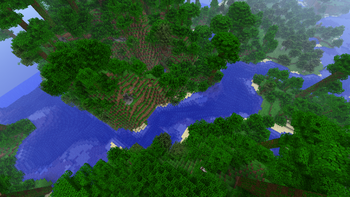
Un río cruzando un bioma de jungla. Arriba a la derecha hay un bosque.
Un río cruzando un bioma de meseta. Abajo a la derecha hay una sabana.
|
Los biomas son regiones en el mundo de Minecraft que se diferencian por características geográficas, flora, temperatura, altitud, nivel de humedad, color del cielo y color del follaje. Los biomas determinan distintos ecosistemas dentro de un mundo, como bosques, junglas, desiertos o llanuras, entre otros.
Temperatura
Los biomas tienen un valor de temperatura que determina si nieva, llueve o si esta despejado o con nubes. Los valores requeridos son menos de 0.15 para la nieve, 0.15 - 0.95 para la lluvia, o más de 1.0 para ninguno. Estos valores se pueden usar para determinar las alturas que genera la nieve en diferentes biomas. La temperatura también cae 0.00166667 (1⁄600) por metro sobre el nivel del mar predeterminado (Y=64), pero no cambia por debajo del nivel del mar. Por ejemplo, las Colinas extremas generan nieve en Y=95, debido al clima de las tierras altas, ya que el valor base es 0.2, y las Sabanas no experimentan lluvia o nieve debido a su calor. La configuración de "nivel del mar" de un mundo personalizado no afecta esto.
Los biomas se dividen en 5 categorías según su temperatura: de nieve, fríos, medios, secos/cálidos y neutros. Se separaron para evitar que los biomas con grandes diferencias de temperatura se ubiquen uno al lado del otro (como la taiga fría junto al desierto) y para permitir que los biomas con temperaturas similares se sitúen uno al lado del otro con más frecuencia. (Como bosques y pantanos)
Tipos de biomas
En Java Edition, Actualmente, hay 67 biomas de Overworld, 1 bioma Nether (5 biomas Nether con Java Edition 1.16), 5 biomas End y 2 biomas no utilizados, con un total de 75 biomas diferentes (79 biomas diferentes en Java Edition 1.16). Plantilla:IN, sin embargo, hay 66 biomas de Overworld, 1 bioma Nether (5 biomas Nether con la edición 1.16.0 de Bedrock), 1 bioma End, y 3 biomas no utilizados, con un total de 71 (74 con la edición 1.16.0 de Bedrock). Los biomas pueden distinguirse por el color de la hierba y de las hojas (el color del agua también difiere entre los biomas del bioma, junto con los tipos de bloques presentes (por ejemplo, tipos de árboles u otras plantas como cactus, cobertura de arena en los desiertos)). Los biomas se generan pseudo-aleatoriamente usando la semilla del mapa
Los biomas se separan en 6 clases de temperatura. Los nevados tienen su temperatura indicada en púrpura, frío en verde, templado/exuberante en naranja, seco/caliente en rojo, y el final en azul. Los biomas de temperatura neutra o desconocida no tienen ninguna clase de temperatura. Las temperaturas se dan a nivel del mar.
Biomas nevados
En estos biomas, siempre nieva en lugar de llover, sin importar la altura; todas las fuentes de agua expuestas al cielo están congeladas
aqua, and the Agua is purple.
| Nombre del bioma e ID | Características | Descripción | Imagen |
|---|---|---|---|
Tundra nevada (Snowy Tundra) |
Temperatura: 0.0
Rainbow Snowfall, Oak Trees[Solo Java Edition], Hielo, Spruce Trees, Igloos, Esqueleto glacials, White and some Black & White Rabbits, Oso polars, Occasional Tall Grass, Villages, Pillager outposts |
Un bioma expansivo y plano con grandes cantidades de capas de nieve. Se generan cañas de azúcar en este bioma,
pero pueden despegarse del suelo cuando se cargan los chunks y las fuentes de agua se convierten en hielo. Se generan robles[Solo Java Edition] y abetos en este bioma. En cuanto a animales, solo se generan conejos y osos polares. Sin embargo, es uno de los pocos biomas donde aparecen esqueletos glaciales. En la versión Bedrock, solo se generan esqueletos y esqueletos glaciales, pero con generadores se pueden generar monstruos. Gracias al tamaño del bioma y la escasez de madera y animales, al principio la supervivencia puede ser difícil en comparación con otros biomas. Este es uno de los dos biomas donde se generan iglús de forma natural. También se pueden generar aldeas y puestos de saqueadores. |
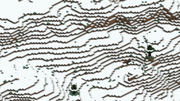 Snowy Tundra |
Picos de hielo (Hielo Spikes) |
Temperatura: 0.0
Packed Hielo, Hielo, Nieve, Snowfall, Snow Blocks, Esqueleto glacials, White and some Black & White Rabbits, Oso polars, Hielo Spikes |
Una variación poco común de la tundra nevada que se caracteriza por sus grandes picos y glaciares de hielo compacto. Normalmente, los picos alcanzan los 10 o 20 bloques de altura, pero algunos picos más altos y delgados alcanzan los 50 bloques de altura. Los glaciares reemplazan los lagos. Casi todos los bloques de césped se reemplazan con bloques de nieve pero se pueden encontrar ocasionalmente bloques de césped en agujeros y bajo salientes. La hierba alta es poco común. Como ocurre con la tundra nevada, no se generan otros animales más que conejos y osos polares y de noche aparecen esqueletos glaciales. | Hielo Spikes |
Taiga nevada (Snowy Taiga) |
Temperatura: -0.5
Nieve, Snowfall, Hielo, Spruce Trees, Flores, Lobos, White and some Black & White Rabbits, Foxes, Igloos, Villages[Solo Bedrock Edition], Pillager outposts, Sweet berry bushes |
Como ocurre con la taiga, este bioma tiene grandes expansiones de abedules, helechos y sus variantes más altas se generan normalmente, pero también se puede encontrar hierba alta. Es uno de los pocos lugares donde los lobos y los zorros se generan de forma natural. También se puede encontrar un iglú entre los árboles en terrenos más o menos planos. También se pueden generar aldeas[Solo BE] y puestos de saqueadores[Solo BE]. Las aldeas usan la misma arquitectura que la de las taigas pero los aldeanos tienen una vestimenta de biomas helados. | 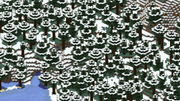 Snowy Taiga |
Montañas de taiga nevada (Snowy Taiga Mountains) |
Temperatura: -0.5
Spruce Trees, Snow, Snowfall, Ferns, Wolves, Sweet berry bushes, Foxes, White and some Black & White Rabbits |
Este bioma está lejos de ser tan plano como su contraparte más común. A comparación de las montañas de taiga, las montañas de este bioma son más empinadas y más erráticas. Gracias a estas diferencias de altura, navegar este bioma es bastante peligroso. También a comparación de su variante, los iglús, las aldeas y los puestos no se generan aquí. |  Snowy Taiga Mountains |
Río congelado (Frozen River) |
Temperatura: 0.0
Hielo, Agua, Arena, Arcilla, Hierba marina, Conejo, Oso polar, Salmón, Ahogado, Esqueleto glacial |
Un río con una capa de hielo que cubre su superficie. Se genera solo si un río entra o se encuentra con una taiga nevada. Se genera salmón bajo el agua y los conejos y los osos polares se generan en el hielo. De noche, se pueden generar ahogados bajo el hielo y esqueletos glaciales en la superficie. No se generan otros monstruos, ni en las profundidades, salvo con un generador. |  Frozen River |
| Playa nevada (Snowy Beach) 26
|
Temperatura: 0.05
Arena, Nieve, Nevada, Hielo, Tesoro enterrado, Naufragio, conejo |
Como en una playa normal, se puede encontrar mucha arena en este bioma y se pueden encontrar tesoros enterrados. Sin embargo, la arena está cubierta por una capa de nieve. Las playas nevadas se encuentran a menudo cuando un bioma nevado. No hay multitudes pasivas que no sean conejos engendran en este bioma. |
 Snowy Beach |
Biomas fríos
En estos biomas, comienza a nevar sobre la capa y=90 en las montañas y en las orillas de piedra, sobre la capa y=120 en las taigas y en las taigas de abedules gigantes y sobre la capa y=150 en las taigas de árboles gigantes. El follaje es de color aqua y el agua de color indigo.
| Biome Name and ID | Características | Descripción | Imágenes |
|---|---|---|---|
Montañas (Mountains) |
Temperatura: 0.2
Oak Trees[Solo JE], Spruce Trees[Solo JE], Gravel, Flowers, Emerald Ore, Infested Stone, Llamas |
Un bioma de altura donde algunas cumbres alcanzan la capa y=130, con algunos robles y abedules esparcidos. Aparecen acantilados, cimas, valles, cascadas, salientes, islas flotantes, cavernas y otras estructuras, lo que ofrece vistas increíbles. Este es uno de los pocos biomas donde se generan llamas de forma natural. También nieva en ciertas alturas, lo que crea capas de nieve en la cima de las montañas. Hay un riesgo significativo de caerse, ya que hay varias cornisas empinadas lo suficientemente altas como para causar daño por caída severo o hasta la muerte. Las montañas son uno de los pocos biomas donde se pueden encontrar menas de esmeralda y lepismas de forma natural. | 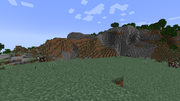 Montañas |
Gravelly Mountains 131
|
Temperatura: 0.2
Spruce Trees[Solo JE], Oak Trees[Solo JE], Gravel, Llama, Emerald ore, Infested stone, Snow |
Las montañas en este bioma son levemente más altas que en su contraparte regular[Solo JE], muchas de las cuales alcanzan las nubes y están cubiertas por cumbres nevadas. El terreno está compuesto principalmente por grava, con pequeños parches de pasto por aquí y por allá. Debido a la poca cantidad de pasto, la población de árboles de abeto y roble en este bioma es escasa. Al generarse junto a un bioma oceánico, puede generar playas normales o frías. |
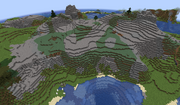 Gravelly Mountains. |
Wooded Mountains 34
|
Temperatura: 0.2
Stone, Dirt, Llama, Emerald ore, Infested stone, Spruce Trees, Oak Trees |
This biome, usually found in the middle of regular mountains biome, generates much taller mountains, most of which are covered by snow. The slopes are quite steep, which makes scaling these mountains difficult and dangerous. The peaks feature much more grass and spruce trees than the Gravelly Mountains, usually forming a small forest at the top. |
 Wooded Mountains |
Gravelly Mountains+ 162
|
Temperatura: 0.2
Spruce Trees, Oak Trees, Gravel, Llama, Emerald ore, Infested stone, Grass |
This variant of the Wooded Mountains biome removes its signature spruce tree covered peaks in favor of terrain covered mostly by gravel and stone, similar to the Gravely Mountains biome. Larger, deeper valleys are carved into the relatively barren landscape - only a few isolated trees can be found here. Just like the Gravelly Mountains Biome, when generating alongside an ocean biome, beaches generate. |
 Gravelly Mountains+ |
Taiga 5
|
Temperature: 0.25
Spruce Trees, Flowers, Fern, Wolves, Brown, salt & pepper and black rabbits, Villages, Pillager outposts, Foxes, Sweet berry bushes, |
A predominantly flat biome covered by a forest of spruce trees. Ferns, large ferns and berry bushes grow commonly on the forest floor. You find packs of wolves here, along with small groups of foxes or rabbits. Villages may generate in this biome; the houses in these villages are built of spruce wood. Pillager outposts may also generate here. |  Taiga |
Taiga Mountains 133
|
Temperature: 0.25
Spruce Trees, Flowers, Ferns, Sheep, Brown, salt & pepper and black rabbits, Sweet berry bushes, Foxes |
The Taiga Mountains biome also features large spruce forests, but these forests are overlayed onto mountainous terrain. Unlike Taiga Hills, these mountains tend to be larger and more difficult to climb. Perhaps owing to the rough nature of this biome, no villages nor outposts can be found here. |
 Taiga Mountains |
Giant Tree Taiga 32
|
Temperature: 0.3
Spruce Trees, Podzol, Ferns, Wolves[Solo JE][próximamente: BE 1.16.0], Brown, salt & pepper and black rabbits[Solo JE], Foxes, Mossy Cobblestone, Mushrooms, Dirt, Coarse Dirt, Dead Bush |
The Giant Tree Taiga is a rare cold biome composed of spruce trees, much like the standard Taiga biome. However, some trees are 2×2 thick and quite tall, akin to large jungle trees. Mossy cobblestone boulders appear frequently, brown mushrooms are common, and podzol can be found on the forest floor. There are also patches of coarse dirt that do not grow grass, with some dead bushes. Wolves and foxes may also spawn here, as they do in normal Taiga biomes. Rabbits may also spawn here in Java Edition. |
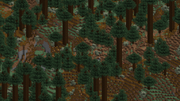 Giant Tree Taiga |
Giant Spruce Taiga 160
|
Temperature: 0.25
Spruce Trees, Podzol, Ferns, Grass, Foxes, Wolf[Solo JE][próximamente: BE 1.16.0], Mossy Cobblestone, Mushrooms, Dirt |
The terrain in this rare biome is almost exactly the same as in its regular counterpart. However, the most striking feature of this biome is its giant spruce trees, which are essentially a scaled-up version of regular spruce trees. One can easily differentiate this from a normal Giant Tree Taiga by observing how the leaves almost completely cover the tree trunks, whereas, in normal Giant Tree Taigas, leaves tend to cover only the top. |
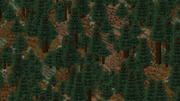 Giant Spruce Taiga |
| Costa Rocosa Stone Shore 25
|
Temperatura: 0.2
Stone, Gravel, Water, Buried Treasure |
Fiel a su nombre, este bioma cubierto de roca a menudo aparece donde los biomas de montaña se encuentran con el océano. Dependiendo de la altura de la tierra cercana, La Costa Rocosa puede generar tanto como pendientes medias como grandes acantilados, alcanza suficiente altura como para ser cubierta de nieve. Aquí no se generan criaturas pasivas. Se pueden generan tesoros enterrados. |
 Costa Rocosa |
Temperate/Lush biomes
In these verdant biomes, it begins snowing over the 256 block height limit, snow does not generate naturally. Otherwise, it rains. The foliage and grass is a vibrant light green, except for swamps and dark forests, which have dark green grass. Rivers and birch forests are also exempt from this, as they have a dull aqua hue. The water is blue in this biome.
| Biome Name and ID | Features | Description | Screenshot |
|---|---|---|---|
Plains 1
|
Temperature: 0.8
Tall Grass, Grass, Flowers, Villages, Horses, Donkeys, Pillager outposts, Oak Trees, Bee Nest |
A flat and grassy biome with rolling hills and few oak trees. Lakes, small underwater caves and villages are common. Cave openings, lava lakes and waterfalls are easily identifiable due to the flat unobstructed terrain. Farm mobs are easily found in Plains biomes; this biome and its variants are also one of the only biomes where horses spawn naturally. Pillager outposts may also be generated. | 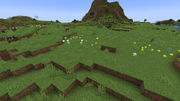 Plains |
| Planicies de Girasoles Sunflower Plains 129
|
Temperature: 0.8
Grass, Sunflowers, Flowers, Donkeys, Villages[Solo BE], Pillager Outposts[Solo BE], Horses, Oak Trees, Bee Nest |
Encontrado dentro de Planicies Normales, este bioma es el único lugar donde los girasoles se generan naturalmente, de ahí el nombre. Crecen en abundancia, haciendo del tinte amarillo un recurso ampliamnete disponible. | 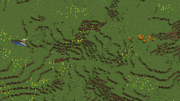 Planicies de Girasoles |
| Bosque Forest 4
|
Temperatura: 0.7
Oak and Birch Trees, Flowers, Wolves[Solo JE][próximamente: BE 1.16.0], Bee nests[Solo JE][próximamente: BE 1.16.0] Mushrooms |
Un bioma pequeño y muy común, con muchos árboles de roble y abedules, sierras ocasionales yuna buena cantidad de hierbas altas, hongos y flores. Este es uno de los biomas más preferidos para comenzar debido a la abundancia de madera. Como en las taigas, se encuentran lobos. | 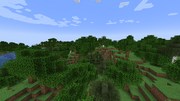 Bosque |
Flower Forest 132
|
Temperature: 0.7
Flowers, Trees, Brown, salt & pepper and black rabbits, Bee Nest |
This Forest variant has fewer trees, but more than makes up for it - it is almost overflowing with nearly every type of flower and tall plant in the game, several of which grow only in this biome. Therefore, this biome is optimal for harvesting and farming dyes. Wolves do not spawn in the flower forest, although rabbits spawn occasionally. | 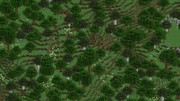 Flower Forest |
Birch Forest 27
|
Temperature: 0.6
Birch Trees, Flowers, Bee nests[Solo JE][próximamente: BE 1.16.0] |
A forest where the grass is aqua and only birch trees generate. Unlike in the regular Forest, no wolves spawn. | 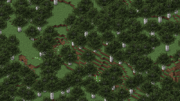 Birch Forest |
Tall Birch Forest 155
|
Temperature: 0.7
Tall Birch Trees, Flowers Bee nests[Solo JE][próximamente: BE 1.16.0] |
Birch trees grow much taller than usual in this uncommon variant of the Birch Forest biome. Whereas normal birch trees grow up to 7 blocks tall, these trees usually are 11 blocks in height. This makes deforestation a much more difficult task, although it provides the player with far more resources. Additionally, the terrain in this biome is much rougher and more erratic than birch forest hills. |  Tall Birch Forest |
Dark Forest 29
|
Temperature: 0.7
Dark Oak trees, Huge Mushrooms, Mushrooms, Rose Bushes, Woodland Mansions |
This biome is composed of dark oak trees, a mostly closed roof of leaves, and occasional large mushrooms. Trees in this forest are so packed together, that it's dark enough for hostile mobs to spawn, even during the day. On rare occasions, a woodland mansion may spawn. Therefore, the Dark Forest is the only biome in which the woodland mansions can be found. |  Dark Forest |
Dark Forest Hills 157
|
Temperature: 0.7
Dark Oak Trees, Huge Mushrooms, Woodland Mansions |
A variant of the Dark Forest where large hills dominate the canopy. While increased light in the forest means slightly fewer mobs, the steep cliffs lining this biome still make it dangerous to navigate on foot. |  Dark Forest Hills |
Swamp 6
|
Temperature: 0.8
Swamp Huts, Oak Trees, Grass, Vines, Lily Pads, Clay, Mushrooms, Slimes, Huge Mushrooms[Solo Bedrock Edition], Fossils, Seagrass |
A biome characterized by a mix of flat areas around sea level and shallow pools of green water with floating lily pads. Clay, sand, and dirt are commonly found at the bottom of these pools. Trees are covered with vines and can be found growing out from the water. Mushrooms and sugar canes are abundant. Swamp Huts with a black cat and a witch generate exclusively in swamps. Slimes also spawn naturally at night, most commonly on full moons. Some zombies may end up underwater, which can transform them into drowned, making this an especially dangerous biome at night. Temperature varies within the biome, causing foliage and grass colors to vary.
En Bedrock Edition, huge mushrooms also spawn in this biome. Visibility is also lower when the player is underwater. |
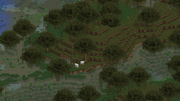 Swamp 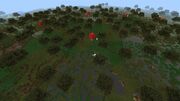 Swamp in Bedrock Edition |
Swamp Hills 134
|
Temperature: 0.8
Oak Trees, Vines, Lilypads, Huge Mushrooms[Solo BE], Water, Swamp huts[Solo BE], Fossils |
This rare biome has areas where small hills rise in slopes of varying degrees, surrounded by flatter marshes. Beaches generate when this biome borders an ocean biome. En Java Edition, Swamp huts do not generate in this biome, unlike the normal Swamp. |  Swamp Hills |
Jungle 21
|
Temperature: 0.95
Jungle Trees, Oak Trees, Jungle Pyramids, Ferns, Melons, Flowers, Vines, Cocoa Pods, Ocelots, Parrots, Bamboo Pandas[Solo BE] |
A dense and uncommon temperated biome. It features ferns and large jungle trees that can reach up to 31 blocks tall with 2×2 thick trunks. Oak trees are also common. The landscape is lush green and quite hilly, with many small lakes often nestled into deep valleys, sometimes above sea level. Leaves cover much of the forest floor—these "bush trees" have single-blocks of jungle wood for trunks, surrounded by oak or jungle leaves. When inside a jungle, the sky becomes noticeably lighter as in dry biomes. Vines are found alongside most blocks and may cover the surface of caves. Ocelots, pyramids, melons, cocoa, pandas and parrots exclusively generate in this biome. Melons generate in patches, similar to pumpkins, but are common. | 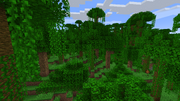 Jungle |
Modified Jungle 149
|
Temperature: 0.95
Jungle Trees, Oak Trees, Ferns, Melons, Flowers, Vines, Cocoa Pods, Ocelots, Parrots, Bamboo Pandas[Solo BE] |
Much more mountainous version of the normal Jungle, with foliage so thick that the ground is barely visible. This biome is demanding of a player's survival resources. One may confuse this with the Jungle Hills, but the hills in the Modified Jungle biome tends to be sharper and more erratic. Due to the combined height of the terrain and of the tall jungle trees, trees in this jungle frequently reach above the clouds. Extremely dense foliage and treacherous terrain make this biome difficult and dangerous to navigate, especially at night. |  Modified Jungle |
Jungle Edge 23
|
Temperature: 0.95
Jungle Trees, Oak Trees, Ferns, Melons, Flowers, Vines, Cocoa Pods, Ocelots, Parrots, Bamboo Pandas[Solo BE] |
This biome represents a smooth transition between jungles and other biomes. In stark contrast to the wild and overgrown vegetation of the jungle biomes, the jungle edge consists of a few small and isolated jungle trees, with patches of melons here and there. The terrain is relatively flat, with some small rises in elevation. All mobs that spawn in the Jungle, including parrots, ocelots, and pandas[Solo Bedrock Edition], also spawn in the Jungle Edge. |  Jungle Edge |
Modified Jungle Edge 151
|
Temperature: 0.95
Jungle Trees, Oak Trees, Ferns, Melons, Flowers, Vines, Cocoa Pods, Ocelots, Parrots, Bamboos Pandas[Solo BE] |
The terrain in this biome is a slightly more hilly and rugged version of the normal Jungle Edge, though some large and flat sections of it are often hard to distinguish from its standard variant. Modified Jungle Edge is the rarest biome in the game and usually generates only when Modified Jungle biomes meet Swamp Hills biomes. The result is a two-layer transition zone that includes a Modified Jungle Edge along the side of the Modified Jungle, and a thin border of normal Jungle Edge on the side of the Swamp Hills. Since Modified Jungles and Swamp Hills are both already rare biomes, in addition to the fact that Modified Jungles are less likely to spawn on the outside edges of jungle biome groups, the Modified Jungle Edge biome is extremely rare. The strict conditions that are needed for its generation also make it a small biome when it does occur, usually no longer than 150 blocks on its long side and less than that for width. |  Modified Jungle Edge |
Bamboo Jungle 168
|
Temperature: 0.95
Jungle Trees, Oak Trees, Podzols, Vines, Ocelots, Jungle Pyramids[Solo Java Edition], Melons, Parrots, Bamboos, Pandas |
The terrain in this biome is covered by grass with some patches of podzol. Unlike the normal Jungle, bushes still generate but do not cover the floor. Additionally, only large jungle trees can generate here along with large or balloon oak trees. The density of trees in this biome is much less compared to jungle edge, but massive amounts of bamboo shoots generate covering this biome. Jungle exclusive mobs such as ocelots and parrots can spawn in here. Panda exclusively spawn in this biome[Solo Java Edition] or have a much higher spawn rate than in regular jungle.[Solo Bedrock Edition] Jungle pyramids can also generate.[Solo Java Edition] | 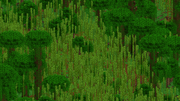 Bamboo Jungle |
River 7
|
Temperature: 0.5
Water, Sand, Clay, Sugar Cane, Seagrass, Salmon, Squid, Drowned |
A biome that consists of water blocks that form an elongated, curving shape similar to a real river. Unlike real rivers, however, they have no current. Rivers cut through terrain or separate the main biomes. They attempt to join up with Ocean biomes, but sometimes loop around to the same area of ocean. Rarely, they can have no connection to an ocean, instead of forming a loop. The grass have a dull aqua tone, much like the ocean, and trace amounts of oak trees tend to generate there as well. Rivers are also a reliable source of clay. These biomes are good for fishing, but drowned can spawn at night. Mobs other than salmon, squid and drowned cannot spawn in this biome, even underground, except in a spawner. | 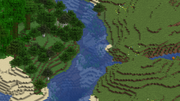 River |
Beach 16
|
Temperature: 0.8
Sand, Gravel, Water, Sugar Cane, Turtles, Buried Treasure, Shipwreck |
Generated where oceans meet other biomes, beaches are primarily composed of sand. Beaches penetrate the landscape, removing the original blocks and placing in sand blocks. These are also useful for fishing. Passive mobs other than turtles do not spawn on beaches. For the history of beaches, see the Beach page. | 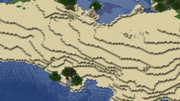 Beach |
Mushroom Fields 14
|
Temperature: 0.9
Mushrooms, Huge Mushrooms, Mycelium, Mooshrooms, No Hostile Mobs |
This rare biome consists of a mixture of flat landscape and steep hills and has mycelium instead of grass as its surface. However, any grass placed appears in a bright green color, even brighter than in the Jungle. Mushroom fields are most often adjacent to an ocean and are usually found isolated from other biomes, and they are typically a few hundred blocks wide. It is one of the only biomes where huge mushrooms can generate naturally, and where mushrooms can grow in full sunlight.
No mobs other than mooshrooms spawn naturally in this biome, including the usual night-time hostile mobs. This also applies to caves, mineshafts, and other dark structures, meaning exploring underground is safe. However, mob spawners still spawn mobs, wandering traders along with their llamas can spawn, raids can still spawn illagers, and the player can still breed animals and spawn mobs using spawn eggs. |
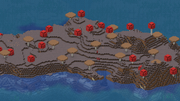 Mushroom Fields |
Mushroom Field Shore 15
|
Temperature: 0.9
Mushrooms, Huge Mushrooms, Mycelium, Mooshrooms, Buried Treasure, Shipwreck, No Hostile Mobs |
Mushroom Field Shores represent the transition between mushroom fields and the ocean, forming long strips between the biomes as a "beach", hence the name. However, it does not generate if the ocean biome is a Deep Ocean. This biome also generates when a river meets a Mushroom Fields biome, similar to what Frozen Rivers do in Snowy Tundras. The terrain of this biome is much more flat and shallow than the main Mushroom Fields biome, though it contains many of the same features, such as a mycelium surface layer, huge mushrooms, and lack of hostile mobs, but shipwrecks and buried treasure can generate here. |  Mushroom Field Shore |
The End biomes
The End is considered a different dimension. The water is lilac.[Bedrock Edition only]
| Biome Name and ID | Features | Description | Screenshot |
|---|---|---|---|
The End 9
|
Temperature: 0.5
End Stone, Endermen, Obsidian, End Crystals, Ender Dragon, End gateway portal, Void |
This biome is used to generate the circle of radius 1000 centered at the 0,0 coordinates in the End. The End central island is generated at the center of this circle, and it's surrounded by a complete vacuum all the way to the edge of the biome. Most of the End features are exclusive to that island, including the ender dragon, the obsidian pillars, the End Crystals, the 5x5 spawn platform, the exit portal and the 20 central End gateways. Large amounts of endermen spawn in this biome. It does not rain or snow in this biome unlike the other low-temperature biomes. The outer islands in the End can be accessed using the End gateway portal after the ender dragon has been defeated. If the biome is used for a superflat world, the sky appears nearly black and an ender dragon spawns at the 0,0 coordinates in the Overworld. Only endermen spawn at night. En Bedrock Edition, this biome contains the entire End dimension. |
 The End |
Small End Islands 40
|
Temperature: 0.5
End stone, Endermen, End gateway portals, Void |
[Solo Java Edition] Generates as part of the outer islands of the End. This biome represents the empty expanse between the larger islands, populated only by the smaller, circular islands. |
 Small End Islands |
End Midlands 41
|
Temperature: 0.5
End stone, Endermen, End gateway portals, End Cities, Shulkers |
[Solo Java Edition] Generates as part of the outer islands of the End. This biome represents the gradual slope from the hilltops of each island down to the cliffs around the edge. End cities generate here, but chorus trees do not. |
 End Midlands |
End Highlands 42
|
Temperature: 0.5
End Stone, Endermen, Chorus Plants, End Cities, Shulkers, End gateway portals |
[Solo Java Edition] Generates as part of the outer islands of the End. This biome represents the hilltops of each island, and is the only biome in the End where both chorus trees and end cities generate. |
 End Highlands |
End Barrens 43
|
Temperature: 0.5
End stone, Endermen, End gateway portals |
[Solo Java Edition] Generates as part of the outer islands of the End. This biome represents the outer rims of each island, with steep cliffs below the edge. Neither end cities nor chorus trees generate in this biome. |
 End Barrens |
Dry/Warm biomes
In these biomes, it neither rains nor snows at all, but the sky still turns overcast during inclement weather. The foliage and grass is an olive tone, except badlands biomes, which have brown grass. The water is light green. As in jungle biomes, the sky becomes lighter. Additionally, a snow golem spawned or brought into one of these biomes melts unless it has the Fire Resistance effect.
| Biome Name and ID | Features | Description | Screenshot |
|---|---|---|---|
Desert 2
|
Temperature: 2.0
Sand, Cacti, Dead Bushes, Sandstone, Sugar Cane, Desert wells, Desert Pyramids, Desert Villages, Pillager Outposts, Gold Rabbits, Fossils, Husk |
A barren and inhospitable biome consisting mostly of sand dunes, dead bushes, and cacti. Sandstone, and sometimes fossils, are found underneath the sand. The only passive mobs to spawn naturally in deserts are gold/creamy rabbits, their coloring well-camouflaged against the sand. At night, husks usually spawn in the place of normal zombies; the lack of visual obstruction makes hostile mobs highly visible. Sugar cane can be found if the desert is next to an ocean or river biome. Desert villages, desert wells, and desert pyramids are found exclusively in this biome. Pillager outposts can also generate here. This biome sometimes appears as a thin edge around badlands biomes. |
 Desert |
Desert Lakes 130
|
Temperature: 2.0
Sand, Cacti, Water, Sugar Canes, Gold Rabbits, Desert well, Fossils, Husk |
In this biome, unlike the normal Desert, patches of water can be found, and the terrain is slightly more rough. Although desert wells can be found, desert pyramids, villages, and outposts do not generate in this biome. |
 Desert Lakes |
| Sabana Savanna 35
|
Temperature: 1.2
Acacia Trees, Tall Grass, Savanna Villages, Horses, Cows, Pillager Outposts, Sheep, Llamas |
A relatively flat and dry biome with a dull-brown grass color and acacia trees scattered around the biome, though oak trees may generate now and then. Tall grass covers the landscape. Villages can generate in this biome, constructed of acacia wood, with some colored terracotta. Pillager outposts can also generate here. Both horses and llamas naturally spawn here. |
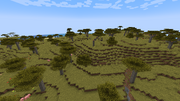 Sabana |
Shattered Savanna 163
|
Temperature: 1.1
Acacia Trees, Oak Trees, Coarse Dirt, Tall Grass, Llama |
Unlike the flat and calm terrain of the savanna biome, the chaotic terrain of this uncommon variant is covered in gigantic mountains covered in coarse dirt and some patch of stone. The mountains in the shattered savanna biome are extremely steep, jutting out at 90-degree angles, making it almost impossible to climb. Deep Ocean-like lakes also generate here. On top of that, they dwarf the mountains biome in height - they can rise far above the clouds, and even to the world height limit, without using the Amplified world type.[Solo Java Edition] Massive waterfalls and lavafalls are quite common here. The unforgiving terrain means villages and outposts do not generate in this biome. Surprisingly, llamas can spawn here. | 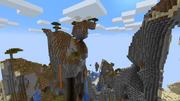 Shattered Savanna |
Badlands 37
|
Temperature: 2.0
Dead Bushes, Terracotta, 6 colors of Terracotta, Red Sand, Cacti, Red Sandstone[Solo JE], Above ground mineshafts, Gold ore |
A rare biome where large mounds of terracotta and stained terracotta generate. Red sand also generates here instead of regular sand, with occasional cacti and dead bushes, and this biome is usually bordered by a desert biome. No passive mobs spawn in this biome, even if all other spawning conditions are met. Mineshafts generate at a higher altitude than normal - occasionally a player may come across a mineshaft jutting out of the Badlands. Gold ore also occurs more frequently, because ore veins generate within badlands at a higher Y-level than the usual 32. The composition of this biome is useful when other sources of terracotta and gold are scarce. However, finding badlands biomes can be difficult due to their rarity. On the other hand, it offers great variety; six variations of this biome are available to explore.
|
 Badlands |
Eroded Badlands 165
|
Temperature: 2.0
Red Sand, Cacti, Red Sandstone[Solo JE], Dead Bushes, Terracotta 6 colors of Terracotta, Above ground mineshaft, Gold ore |
This rare biome generates unique terrain features that are similar to the structures in Utah's Bryce Canyon. Tall and narrow spires of colorful terracotta rise out of the floor of the canyon, which like all other badlands variants, is covered in red sand. Deserts do not generate alongside this biome. |
 Eroded Badlands |
Wooded Badlands Plateau 38
|
Temperature: 2.0
Oak trees, Dead Bushes, Dirt, Terracotta, 6 colors of Terracotta |
One might not notice the difference between the normal badlands plateau and this variation, if it weren't for the layer of coarse dirt and the small forests of oak trees that generate atop these plateaus. The color of the grass and leaves is a dull green-brown hue, giving it a dried and dead appearance. These trees are a rare source of wood when living in the otherwise barren and lifeless badlands. |
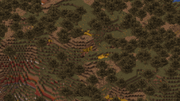 Wooded Badlands Plateau |
Modified Wooded Badlands Plateau 166
|
Temperature: 2.0
Oak trees, Dead Bushes, Dirt, Terracotta, 6 colors of Terracotta |
This biome features grass and oak trees on top of plateaus, much like its counterpart. However, the plateaus that generate here are generally smaller, allowing far less foliage to generate. The terrain is more erratic, and can be compared to that of the similar Modified Badlands Plateau biome, having an old and eroded appearance. Deserts do not generate alongside this biome. |
 Modified Wooded Badlands Plateau |
| Plateau(s) 36, 39
|
Temperature: Badlands Plateau : 2.0 |
Savanna plateau biomes are similar to the Hills biomes, but generate only within Savanna, while badlands plateau generate as actual biomes in Badlands biomes, and are flattened at the top, much like real-life plateaus. They come to rest at an elevation of about 20 to 30 blocks above sea level. One may discover the entrance to a mineshaft within the tall slopes of a Badlands Plateau. |
 Badlands Plateau  Savanna Plateau |
| Modified Plateau(s) 164, 167 |
Temperature: Modified Badlands Plateau : 2.0 |
Two rare variants of the plateau biomes, which are variants themselves. However, neither of these biomes closely resemble their counterparts.
Compared to the average Badlands Plateau, the Modified Badlands Plateau features more variable terrain and smaller plateaus, as if a larger plateau was weathered down over time. The terrain of the Shattered Savanna Plateau biome is much less tame than its normal counterpart. It features incredibly large and steep mountains that jut out of the terrain, similar to the Shattered Savanna biome, albeit slightly smaller and gentler in comparison. Rain can occur in shattered savanna plateau.[Solo BE] |
 Modified Badlands Plateau  Shattered Savanna Plateau |
Biomas de Nether
Así como en the End, the Nether es una dimensión diferente. Todos los biomas en esta dimensión son secos y no es posible colocar agua en esas dimensiones, aunque el hielo aún puede colocarse.
| Biome Name and ID | Características | Descripción | Imágenes | |
|---|---|---|---|---|
Nether Wastes [próximamente: JE 1.16 & BE 1.16.0] Nether 8
|
Temperature: 2.0
Netherrack, Glowstone, Soul Sand, Nether Quartz Ore, Ghasts, Blazes, Zombie Pigmen, Nether Fortresses, Wither Skeletons, Lava, Magma cubes, Gravel, Magma Blocks, Bastion Remnants[próximamente], Ruined Portals[próximamente] |
This is the biome used to generate the Nether. Within this biome spawn mobs such as ghasts, packs of zombie pigmen and the occasional magma cubes and endermen. Certain structures, such as Nether quartz ore & glowstone veins, and Nether fortresses generate only in the Nether. Water lakes (and other Overworld structures) can still generate if the Nether is used in a superflat preset. Beds explode when used in this biome. |
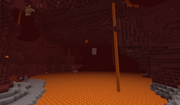 Nether Wastes, formerly only called "Nether" | |
| Temperature: 2.0
Netherrack, Glowstone, Soul Sand, Stone, Water, Lava, Gravel, Nether fortresses (when generated through Buffet mode) | ||||
| Temperature: 2.0
Stone, Lava, Water, Bedrock, Zombie Pigman, Ghast, Magma Cube (when generated in overworld)[Solo Bedrock Edition] | ||||
Soul Sand Valley [próximamente: JE 1.16 & BE 1.16.0] 170 |
Temperature: 2.0
Soul Sand, Soul Soil, Soul Fire, Netherrack, Basalt in Basalt pillars, Bone Blocks in Nether fossils, Ghast, Skeleton, Endermen, Bastion Remnants, Ruined Portals |
The soul sand valley is a large grotto that is extensive and cuts through the Nether's usual terrain. Notable features of the biome are exposed nether fossils in various shapes and sizes, large amounts of lava, blue fog, large spires made of basalt, soul fire, and the occasional Nether fortress or Bastion remnant. The biome itself consists of soul sand, basalt and soul soil.
This biome is extremely dangerous to traverse due to the combination of ghasts and skeletons spawning here and soul sand slowing down the player's movement speed, making it easy for a player to get overwhelmed by projectile attacks. In addition, ghasts fireballs impacting soul sand or soul soil can create soul fire, which is more harmful than regular fire if players get caught in it. It is recommended to avoid this biome unless players have sufficient equipment/strategies to navigate the terrain. The Soul Speed enchantment is especially helpful for travelling through this biome. |
Soul Sand Valley | |
Crimson Forest [próximamente: JE 1.16 & BE 1.16.0] 171 |
Temperature: 2.0
Crimson Nylium, Crimson Fungi, Warped Fungi, Crimson Roots, Glowstone, Weeping Vines, Huge Crimson Fungi, Nether Wart Blocks, Shroomlight, Hoglins, Piglins, Zombified Piglins, Bastion Remnants, Ruined Portals |
The Crimson Forest is a “red” crimson-themed biome, with warped and crimson fungi as well as huge crimson fungi scattered around the environment.
There are huge fungi structures that contain weeping vines hanging off them and may also have a few blocks of shroomlight. The floor of the biome is covered in crimson nylium, with crimson roots growing. Occasional patches of netherrack and red nether wart blocks are found scattered throughout the biome. In the ceiling, apart from glowstone clusters, there are sparse nether wart block stalactites with vines growing. Piglins, zombified piglins and hoglins naturally spawn in this biome. As long as players equip at least one piece of gold armor, piglins should not cause any trouble. Hoglins can also be repelled by staying close to warped fungi. However, without these countermeasures, this biome can be fairly hostile to navigate. Nevertheless, the abundance of hoglins in this biome makes it a great source of food in the Nether, and the high population of piglins makes this biome an ideal location to barter with them. |
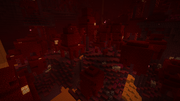 Crimson Forest | |
Warped Forest [próximamente: JE 1.16 & BE 1.16.0] 172 |
Temperature: 2.0
Warped Nylium, Crimson Fungi, Warped Fungi, Warped Roots, Nether Sprouts, Huge Warped Fungi, Warped Wart Blocks, Shroomlight, Enderman, Bastion Remnants, Ruined Portals |
The warped forest is a dense, “blue” warped-themed biome, with warped and crimson fungi as well as huge warped fungi scattered around.
The huge fungi structures may have a few blocks of shroomlight scattered around them. The floor of the biome is covered in warped nylium, with warped roots and nether sprouts growing. Occasional patches of raw netherrack and warped wart blocks can be found scattered throughout the biome. Apart from Striders, Endermen are the only mobs that spawn in this biome, making the warped forest an ideal location to collect ender pearls to access the End. This biome is also a relatively safe place to reside in the Nether, due to the fact that no hostile mobs spawn here. However, do note that other hostile mobs can still spawn from Bastion remnants that generate here, as well as from Nether fortresses that have cut into a warped forest after generating in another biome. |
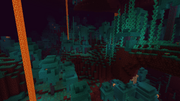 Warped Forest | |
Basalt Deltas [próximamente: JE 1.16 & BE 1.16.0] 173 |
Temperature: 2.0
Basalt, Blackstone, Netherrack, Lava, Magma Cubes, Striders, Ghasts, Ruined Portals |
A gray biome, the basalt deltas are said to be the remnant of ancient volcanic eruptions.
The ground consists of basalt and blackstone blocks, with small patches of netherrack and pools of lava. The shape of the terrain is chaotic and uneven, making it somewhat difficult to traverse and build on. Unlike the other biomes in the Nether, Bastion remnants do not generate in basalt deltas. When this biome borders a lava ocean, clusters of basalt form near the coast. Magma cubes have a high spawn rate in this biome, making the Basalt Deltas the best place to farm Magma Cream. This biome also contains a much higher abundance of blackstone compared to other Nether biomes. |
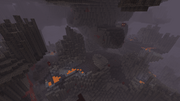 Basalt Deltas |
Biomas Oceánicos
Oceans are large, open biomes made entirely of water going up to y=63, with underwater relief on the sea floor, such as small mountains and plains, usually including gravel. Oceans typically extend under 3,000 blocks in any direction; around 60% of the Overworld's surface is covered in ocean. Small islands with infrequent vegetation can be found in oceans. Passive mobs sometimes can spawn on these islands, as hostiles can. Squid spawn frequently in the water. Underwater cave entrances can be found frequently at the bottom of the ocean.
| Biome Name and ID | Features | Description | Screenshot |
|---|---|---|---|
Warm Ocean 44
|
Temperature: 0.5
Dolphins |
A variant of the Ocean biome, with light green water at the surface. Like the Lukewarm Ocean, it has a floor made of sand, and like all oceans, it is populated with seagrass. Unlike other ocean biomes, Warm Oceans allow for the generation of coral reefs and sea pickles, but not kelp. | 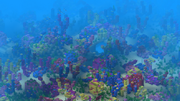 Warm Ocean |
Lukewarm Ocean 45
|
Temperature: 0.5
Dolphins, Pufferfish[Solo JE], Tropical fishes[Solo JE], Squid, Salmon[Solo BE] Cod, warm underwater ruins, Sand, Dirt, Clay, Drowned, Kelp, Seagrass, Shipwrecks, Magma blocks |
A variant of the Ocean biome, with light teal water at the surface. Its floor is made of sand with the occasional dirt or clay, and it contains kelp and seagrass. Unlike the Warm Ocean biome, cod and salmon[Solo BE] can spawn here. | 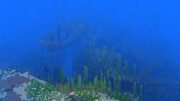 Lukewarm Ocean |
Deep Lukewarm Ocean 48
|
Temperature: 0.5
Dolphins, Pufferfish[Solo JE], Tropical fishes[Solo JE], Salmon[Solo BE] Cod, warm underwater ruins, Sand, Dirt, Clay, Drowned, Squid, Kelp, Seagrass, Ocean monuments, Guardians, Elder guardians, shipwrecks, Magma Blocks |
Similar to the Lukewarm Ocean biome, but twice as deep. Because they are a Deep Ocean variant, they can generate ocean monuments, resulting in the spawning of guardians, elder guardians, prismarine, and sponges. | 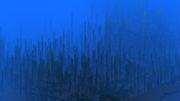 Deep Lukewarm Ocean |
Ocean 0
|
Temperature: 0.5
Water, Gravel, Squid, Sand, Seagrass, Kelp, Shipwreck, Cold Underwater ruins, Cod, Salmon[Solo BE], Drowned, Magma block |
The basic Ocean biome. Like its colder variants, its floor is made up of gravel. Sea grass, kelp, cod and salmon[Solo Bedrock Edition] can spawn here. |
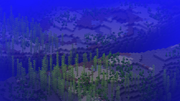 Ocean |
Deep Ocean 24
|
Temperature: 0.5
Water, Gravel, Clay, Squid, Guardians, Elder Guardians, Ocean monuments, Shipwreck, Cold underwater ruins, Kelp, Seagrass, Cod, Salmon, Drowned, Magma Block |
A variant of the Ocean biome. In Deep Ocean biomes, the ocean can exceed 30 blocks in depth, making it twice as deep as the normal ocean. The ground is mainly covered with gravel. Ocean monuments generate in deep oceans, meaning guardian and elder guardian can spawn here. Underwater ravines often generate here, with the top layer of lava being replaced by magma blocks that create bubble columns. |
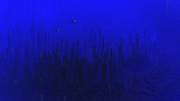 Deep Ocean |
Cold Ocean 46
|
Temperature: 0.5
Dolphins, Cod, Salmon, Cold underwater ruins, Gravel, Kelp, Seagrass, Dirt, Sand, shipwreck, magma blocks, squid, Drowned |
A variant of the Ocean biome, with dark indigo water at the surface. Like regular Oceans and Frozen Oceans, its floor is made up of gravel, though you can find some patches of dirt. Salmon are able to spawn in Cold Ocean biomes. | 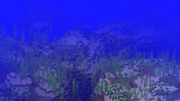 Cold Ocean |
Deep Cold Ocean 49
|
Temperature: 0.5
Dolphins, Cod, Salmon, Cold underwater ruins, Gravel, Kelp, Seagrass, Dirt, Sand, Ocean monuments, Guardians, Elder guardians, shipwrecks, Drowned, Squid |
Similar to the Cold Ocean biome, but twice as deep. Like other Deep Oceans, ocean monuments are able to generate here, which contain guardians, elder guardians, prismarine, and sponges. | 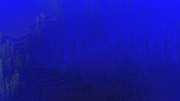 Deep Cold Ocean |
Frozen Ocean 10
|
Temperature: 0.0
Ice, Packed Ice, Blue Ice, Water, Gravel, Clay, Squid, Sand, Cod[Solo BE], Drowned, Salmon, Iceberg, Shipwreck, Cold underwater ruins, Stray, Polar Bear, Rabbit |
A variant of the Ocean biome with dark purple water at the surface. Like the Cold Ocean, it has a gravel seabed and squid swimming about. However, the water's surface is frequently broken up by patches of ice and large icebergs, consisting of packed ice and, occasionally, blue ice. Strays and polar bears can spawn here, but dolphins do not. |
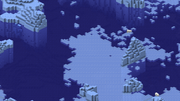 Frozen Ocean |
Deep Frozen Ocean 50
|
Temperature: 0.5
Salmon, Cold underwater ruins, Gravel, Ice[Solo BE], Packed Ice, Blue Ice, Ocean monuments, Guardians, Elder guardians, iceberg, shipwreck, Polar Bear, Stray, rabbit, cod[Solo BE], drowned, squid |
Like the Frozen Ocean biome, the only fish that can spawn here are salmon and cod[Solo BE], and the floor is made up of gravel. The Frozen Deep Ocean biome also contains ocean monuments and a deeper floor than normal Oceans, like other Deep Oceans. Unlike its shallow counterpart, the surface of the water is not frozen[Solo JE]. Frequent floating icebergs with blue ice generate here. Polar bears, rabbits, and strays can also spawn here, but dolphins do not. | 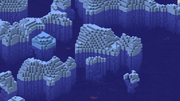 Deep Frozen Ocean |
Neutral biomes
| Biome Name and ID | Features | Description | Screenshot |
|---|---|---|---|
The Void[Solo Java Edition] 127
|
Temperature: 0.5
Stone, Cobblestone, Void |
Can be accessed only through Buffet world selection or The Void superflat preset. In a Buffet world, the landscape consists only of stone, as well as water and bedrock depending on the generator type. In The Void superflat preset, the world is empty except for a single structure: a 33×33 stone platform with a single block of cobblestone in the center. No mobs (passive or hostile) can spawn without spawn eggs, spawners, or commands. |  The Void |
| Hills 13, 17, 18, 19, 22, 28, 31, 33, 156, 161
|
Temperature: Same as their respective base biomes. | Hills are generated within certain biomes (including some of their variants) and are referred in the F3 menu with Hills or Mountains added to their name.
This includes: Wooded Hills, Taiga Hills, Snowy Taiga Hills, Jungle Hills, Desert Hills, Birch Forest Hills, Tall Birch Hills, Giant Tree Taiga Hills, Giant Spruce Taiga Hills, and Snowy Mountains. Most hills are gentle rolling slopes on which the usual biome terrain generates, with some sharper cliffs here and there. Snowy Mountains are usually taller, with height comparable to mountains biomes, and have a lower chance of spawning passive mobs during world generation than other biomes (7% versus 10%). Giant Spruce Taiga Hills are a special case. en Java Edition, the game code sets the values |
 Giant Tree Taiga Hills  Desert Hills  Jungle Hills  Snowy Mountains |
Biomas no utilizados
- Artículo principal: Unused features
Estos biomas no se generan en mundos predeterminados.
| Biome Name and ID | Features | Description | Screenshot |
|---|---|---|---|
Mountain Edge 20
|
Temperature: 0.2
Grass, Dirt, Stone, Llamas, Emerald ore, Infested stone, Spruce trees, Oak trees, Snow |
Similar to the jungle edge biome, the Mountain Edge used to generate exclusively at the edge of Mountain biomes in order to smooth the transition between biomes. This biome has lots of trees, similar to wooded mountains. While the terrain is lower and gentler in nature, some areas may reach high enough to be covered by snow. This biome doesn't generate naturally from Java Edition 1.7.2 onward. |  Mountain Edge |
Deep Warm Ocean 47
|
Temperature: 0.5
Dolphins, Pufferfish, Tropical fishes, Warm underwater ruins, Sand, Seagrass, Ocean monuments, Guardians, Elder guardians, shipwrecks |
Similar to the Warm Ocean biome, but without coral reefs nor sea pickles, and twice as deep. Because they are a deep ocean variant, they can generate ocean monuments, resulting in the spawning of guardians, elder guardians, prismarine, and sponges. This biome has never naturally generated. | 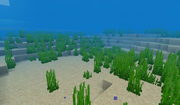 Deep Warm Ocean |
Legacy Frozen Ocean[Solo Bedrock Edition] -116
|
Temperature: 0.0
Polar Bears, Salmon, Cod, Strays, Cold underwater ruins, Gravel, Seagrass, kelp, Snowy Rabbits, Ice, shipwrecks |
Similar to the Frozen Ocean biome, but without icebergs. Because they are a Frozen Ocean variant, they can spawn polar bears and strays, but not dolphins. Unlike the regular frozen ocean, Polar bear, drowned, squid, salmon, cod, Rabbits, skeletons and strays are only mobs that spawn here, kelp also generates here. This biome doesn't generate naturally from Pocket Edition Alpha 0.9.0 onward. |  Legacy Frozen Ocean |
Biomas removidos
- Artículos principales: Biome/Before Beta 1.8 y Removed features
Estos biomas no se generan más en versiones actuales del juego.
| Biome Name and ID | Features | Description | Screenshot |
|---|---|---|---|
Tundra
|
Temperature: <50%
Snow, Grass Block, Ice |
Snowy, barren terrain with few trees. The occasional trees do exist, although rarely. Ice can be found over water. Snow is common weather in tundras. It generates when the temperature is below 50% and the rainfall is less than 20%. |
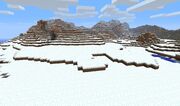 Tundra |
Rain Forest
|
Temperature: >97%
Grass Block, Grass, Oak trees, Birch trees |
Rainforests are wet biomes with many trees, which have a 1 in 3 chance of being big, instead of 1 in 10 like all other biomes. They generate only oak trees and have a large amount of tall grass and ferns. A biome is classified as a rainforest if the temperature is greater than 97% and the rainfall is more than 90%. This could be the biome with some of the most cliffs and hills because the world generator reduces height variation at lower rainfalls. |
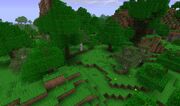 Rainforest |
Seasonal Forest
|
Temperature: >97%
Grass Block, Grass, Oak trees |
Seasonal Forests spawn with a temperature of 97% or greater, and a rainfall value between 45% and 90%. They are commonly found between forest and rain forests, and near plains biomes. They are identical to forests, except they have fewer trees and are capable of spawning only oak trees. They have a little bit of tall grass. |
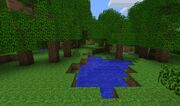 Seasonal Forest |
Ice Desert
|
Temperature: 0.0
Sand, Snow, Ices |
An unused biome before Beta 1.8 that was in the code but never implemented into the temperature/rainfall table and thus did not actually generate. It was a biome of sand with snow on top of it and had snowfall and ice. |
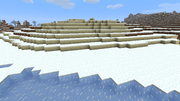 Ice Desert |
Shrubland
|
Temperature: >50%, <97%
Grass Block, Oak trees, Birch trees |
A biome with few trees and no tall grass. It is identical to the savanna biome. It is one of the smallest biomes in the game and spawns only if the temperature is between 50% and 97%, and the rainfall value is below 35% and therefore too little to generate a forest. |
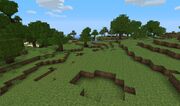 Shrubland |
Biome IDs
- Artículo principal: Java Edition data values#Biome IDs
Cada tipo de bioma tiene su propio ID de bioma, que se muestra en la siguiente tabla.
| Name | Resource location | Numeric ID |
|---|---|---|
| Océano | ocean
|
0 |
| Océano profundo | deep_ocean
|
24 |
| Océano helado | frozen_ocean
|
10 |
| Océano helado profundo | deep_frozen_ocean
|
50 |
| Océano frío | cold_ocean
|
46 |
| Océano frío profundo | deep_cold_ocean
|
49 |
| Océano tibio | lukewarm_ocean
|
45 |
| Océano tibio profundo | deep_lukewarm_ocean
|
48 |
| Océano cálido | warm_ocean
|
44 |
| Río | river
|
7 |
| Río helado | frozen_river
|
11 |
| Playa | beach
|
16 |
| Costa rocosa | stony_shore
|
25 |
| Playa nevada | snowy_beach
|
26 |
| Bosque | forest
|
4 |
| Bosque floral | flower_forest
|
132 |
| Abedular | birch_forest
|
27 |
| Abedular ancestral | old_growth_birch_forest
|
155 |
| Bosque oscuro | dark_forest
|
29 |
| Jungla | jungle
|
21 |
| Jungla dispersa | sparse_jungle
|
23 |
| Jungla de bambú | bamboo_jungle
|
168 |
| Taiga | taiga
|
5 |
| Taiga nevada | snowy_taiga
|
30 |
| Taiga de pinos ancestral | old_growth_pine_taiga
|
32 |
| Taiga de abetos ancestral | old_growth_spruce_taiga
|
160 |
| Campo de champiñones | mushroom_fields
|
14 |
| Pantano | swamp
|
6 |
| Sabana | savanna
|
35 |
| Meseta de sabana | savanna_plateau
|
36 |
| Sabana ventiscosa | windswept_savanna
|
163 |
| Llanura | plains
|
1 |
| Llanura de girasoles | sunflower_plains
|
129 |
| Desierto | desert
|
2 |
| Llanura nevada | snowy_plains
|
12 |
| Picos de hielo | ice_spikes
|
140 |
| Colinas ventiscosas | windswept_hills
|
3 |
| Bosque ventiscoso | windswept_forest
|
34 |
| Colinas pedregosas ventiscosas | windswept_gravelly_hills
|
131 |
| Páramo | badlands
|
37 |
| Páramo frondoso | wooded_badlands
|
38 |
| Páramo erosionado | eroded_badlands
|
165 |
| Cuevas kársticas | dripstone_caves
|
174 |
| Cuevas frondosas | lush_caves
|
175 |
| Desiertos del Nether | nether_wastes
|
8 |
| Bosque carmesí | crimson_forest
|
171 |
| Bosque distorsionado | warped_forest
|
172 |
| Valle de almas | soul_sand_valley
|
170 |
| Deltas de basalto | basalt_deltas
|
173 |
| El End | the_end
|
9 |
| Islas pequeñas del End | small_end_islands
|
40 |
| Islas medias del End | end_midlands
|
41 |
| Islas grandes del End | end_highlands
|
42 |
| Baldíos del End | end_barrens
|
43 |
| El Vacío | the_void
|
127 |
| Prado | meadow
|
177 |
| Arboleda | grove
|
178 |
| Ladera nevada | snowy_slopes
|
179 |
| Cumbres heladas | frozen_peaks
|
180 |
| Cumbres escarpadas | jagged_peaks
|
181 |
| Cumbres rocosas | stony_peaks
|
182 |
| Naombre | Ubicación del recurso | Identificación numérica |
|---|---|---|
| Océano | ocean
|
0 |
| Océano congelado heredado | legacy_frozen_ocean
|
47 |
| Océano profundo | deep_ocean
|
24 |
| Océano helado | frozen_ocean
|
10 |
| Océano helado profundo | deep_frozen_ocean
|
46 |
| Océano frío | cold_ocean
|
42 |
| Océano frío profundo | deep_cold_ocean
|
45 |
| Océano tibio | lukewarm_ocean
|
41 |
| Océano tibio profundo | deep_lukewarm_ocean
|
44 |
| Océano cálido | warm_ocean
|
40 |
| Océano cálido profundo | deep_warm_ocean
|
43 |
| Río | river
|
7 |
| Río helado | frozen_river
|
11 |
| Playa | beach
|
16 |
| Costa pedregosa | stone_beach
|
25 |
| Playa nevada | cold_beach
|
26 |
| Bosque | forest
|
4 |
| Colinas boscosas | forest_hills
|
18 |
| Bosque de flores | flower_forest
|
132 |
| Bosque de abedules | birch_forest
|
27 |
| Colinas de bosque de abedules | birch_forest_hills
|
28 |
| Bosque de abedules antiguo | birch_forest_mutated
|
155 |
| Colinas altas de abedules | birch_forest_hills_mutated
|
156 |
| Bosque oscuro | roofed_forest
|
29 |
| Colinas de bosque oscuro | roofed_forest_mutated
|
157 |
| Jungla | jungle
|
21 |
| Colinas de jungla | jungle_hills
|
22 |
| Jungla modificada | jungle_mutated
|
149 |
| Jungla dispersa | jungle_edge
|
23 |
| Jungla dispersa modificada | jungle_edge_mutated
|
151 |
| Jungla de bambú | bamboo_jungle
|
168 |
| Colinas de jungla de bambú | bamboo_jungle_hills
|
169 |
| Taiga | taiga
|
5 |
| Colinas de taiga | taiga_hills
|
19 |
| Taiga Mountains | taiga_mutated
|
133 |
| Taiga nevada | cold_taiga
|
30 |
| Colinas de taiga nevada | cold_taiga_hills
|
31 |
| Montañas de taiga nevada | cold_taiga_mutated
|
158 |
| Taiga de pino viejo | mega_taiga
|
32 |
| Colinas de la taiga de árboles gigantes | mega_taiga_hills
|
33 |
| Taiga de abeto antiguo | redwood_taiga_mutated
|
160 |
| Colinas de taiga de abetos gigantes | redwood_taiga_hills_mutated
|
161 |
| Campo de champiñones | mushroom_island
|
14 |
| Orilla del campo de hongos | mushroom_island_shore
|
15 |
| Pantano | swampland
|
6 |
| Colinas de pantano | swampland_mutated
|
134 |
| Sabana | savanna
|
35 |
| Meseta de sabana | savanna_plateau
|
36 |
| Sabana azotada por el viento | savanna_mutated
|
163 |
| Meseta de sabana destrozada | savanna_plateau_mutated
|
164 |
| Llanuras | plains
|
1 |
| Llanuras de girasol | sunflower_plains
|
129 |
| Desierto | desert
|
2 |
| Colinas del desierto | desert_hills
|
17 |
| Lagos del desierto | desert_mutated
|
130 |
| Llanuras nevadas | ice_plains
|
12 |
| Montañas nevadas | ice_mountains
|
13 |
| Picos de hielo | ice_plains_spikes
|
140 |
| Colinas azotadas por el viento | windswept_hills
|
3 |
| Bosque azotado por el viento | windswept_forest
|
34 |
| Colinas de grava azotadas por el viento | windswept_gravelly_hills
|
131 |
| Montañas de grava+ | extreme_hills_plus_trees_mutated
|
162 |
| Borde de la montaña | extreme_hills_edge
|
20 |
| Tierras baldías | mesa
|
37 |
| Meseta de tierras baldías | mesa_plateau
|
38 |
| Meseta de tierras baldías modificada | mesa_plateau_mutated
|
166 |
| Meseta boscosa de tierras baldías | mesa_plateau_stone
|
39 |
| Meseta boscosa de tierras baldías modificada | mesa_plateau_stone_mutated
|
167 |
| Tierras baldías erosionadas | mesa_bryce
|
165 |
| Prado | meadow
|
186 |
| Arboleda | grove
|
185 |
| Pistas nevadas | snowy_slopes
|
184 |
| Picos irregulares | jagged_peaks
|
182 |
| Picos helados | frozen_peaks
|
183 |
| Picos pedregosos | stony_peaks
|
189 |
| Cuevas luminosas | lush_caves
|
187 |
| Cuevas de espeleotema | dripstone_caves
|
188 |
| Desiertos del Nether | hell
|
8 |
| Bosque carmesí | crimson_forest
|
179 |
| Bosque distorsionado | warped_forest
|
180 |
| Valle de almas | soulsand_valley
|
178 |
| Deltas de basalto | basalt_deltas
|
181 |
| El End | the_end
|
9 |
Colores del Bioma

Biome colors template for 1.7.2 and above.

grass.png

foliage.png
The temperature and rainfall values of a biome are used when determining the colors of grass, foliage (excluding the stalks of flowers), and other features such as water and the sky.
A biome's rainfall value is typically a value from 0.0 to 1.0, and - as stated above - a biome's temperature starts at a given value at sea level (e.g. 2.0 for Desert or -0.5 for Cold Taiga) and decreases by 0.00166667 for each meter above sea level.
Biome grass and foliage colors are selected from two 256x256 colormap images: grass.png and foliage.png. Both colormaps, shown to the right, can be found in assets\minecraft\textures\colormap. The grass.png colormap sets the colors for the grass block top and sides (along with other types of grass, such as tall grass, ferns, double tall grass, etc.). Meanwhile, the foliage.png colormap sets the colors for tree leaves (with the exception of spruce and birch).
Biome colormaps use a triangular gradient by default. However, only the colors in the lower-left half of the image are used, even though the upper-right side of foliage.png is colored. Furthermore, as shown in the template image to the left, only select few pixels are considered when the colormap is read by the game, and are determined by the code below.
The adjusted temperature and adjusted rainfall values (recognized as AdjTemp and AdjRainfall in the code, respectively) are used when determining which biome color to select from the colormap. Treating the bottom-right corner of the colormap as Temperature = 0.0 and Rainfall = 0.0, the adjusted temperature increases to 1.0 along the X-axis, and the adjusted rainfall increases to 1.0 along the Y-axis. The values used to retrieve the colors are computed as follows:
AdjTemp = clamp( Temperature, 0.0, 1.0 ) AdjRainfall = clamp( Rainfall, 0.0, 1.0 ) * AdjTemp
"clamp" limits the range of the temperature and rainfall to 0.0-1.0. The clamped rainfall value is then multiplied by the 0.0-1.0 adjusted temperature value, which brings its value to be inside the lower left triangle. Some biomes' ranges are shown in the template above; the multiplication makes all the line segments point towards the lower right corner.
At borders between or among biomes, the colors of the block and its eight neighbors are computed and the average is used for the final block color.
Exact temperature and rainfall values for biomes can be found in various projects, e.g. this biome code.
Hard-coded colors
Certain biome colors are hard-coded, which means they are locked into the Minecraft code and are not retrievable from any texture file. Thus, they cannot be modified without the use of external tools, such as MCPatcher/OptiFine, that support the use of custom colormaps.
Swampland color
Swampland temperature, which starts at 0.8, is not affected by altitude. Rather, a Perlin noise function is used to gradually vary the temperature of the swampland. When this temperature goes below -0.1, a lush green color is used (0x4C763C) otherwise it is set to a sickly brown (0x6A7039). In addition, the color of the water in swamplands is always multiplied by a very light green tinge (0xE0FFAE).
Roofed forest color
The roofed forest biomes' grass color is retrieved normally, then averaged with a dark green color (0x28340A) to produce the final color.
Mesa color
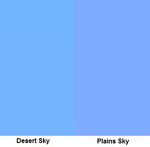
The color of the sky in two different biomes.
All mesa biomes' grass and foliage have hard-coded colors, which are two tan colors (0x90814D and 0x9E814D respectively). These are not modifiable by grass.png and foliage.png, and are unaffected by temperature.
Other colors
Several other biome colors are set into the game and currently require external tools in order to be changed. This includes blocks such as birch and spruce leaves and water (which have a hard-coded overlay set onto them), and other features such as the sky and fog.
Achievements
Plantilla:Load achievements
Videos
- Artículo principal: Biome/video [editar]
Advancements
[[Mojira:MC-Plantilla:Carga de progresos: Progreso desconocido. El título del progreso no se ha podido encontrar en la página Progreso|MC-Plantilla:Carga de progresos: Progreso desconocido. El título del progreso no se ha podido encontrar en la página Progreso]]
History

A very old image of biomes work-in-progress. "To the right of the player is a taiga, to the left is either a forest, or woods, I can’t remember. In the distance is probably tundra." ~ Notch
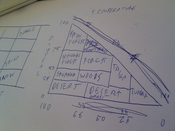
The biomes graph from Notch, prior to beta 1.8. Notice the chicken scratch handwriting, as Notch was working quick to try to get the biomes update out.
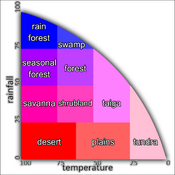
The old biomes graph with linear axes.
Plantilla:History Plantilla:History Plantilla:History Plantilla:History Plantilla:History Plantilla:History Plantilla:History Plantilla:History Plantilla:History Plantilla:History Plantilla:History Plantilla:History Plantilla:History Plantilla:History Plantilla:History Plantilla:History Plantilla:History Plantilla:History Plantilla:History Plantilla:History Plantilla:History Plantilla:History Plantilla:History Plantilla:History Plantilla:History Plantilla:History Plantilla:History Plantilla:History Plantilla:History Plantilla:History Plantilla:History Plantilla:History Plantilla:History Plantilla:History Plantilla:History Plantilla:History Plantilla:History Plantilla:History Plantilla:History Plantilla:History Plantilla:History Plantilla:History Plantilla:History Plantilla:History Plantilla:History Plantilla:History Plantilla:History Plantilla:History Plantilla:History Plantilla:History Plantilla:History Plantilla:History Plantilla:History Plantilla:History Plantilla:History
Issues
Plantilla:Issue list
Trivia
- The term biome is analogous to its scientific usage: in real life, a biome is climatically and geographically defined by distinctive communities of plants, animals and soil organisms supported by similar climatic conditions. They are often referred to as ecosystems.[2][3]
- Los unicos biomas inventados son el NETHER (Hell), El End y aquellos con hongos gigantes. Todos los demas estas completamente o parcialmente inspirados en su contraparte de la vida real
Gallery
The first image of a mega taiga, as tweeted by Jeb.
Sunrises and Sunsets
References
Plantilla:Reflist
See also
- The Overworld
- Generated structures
- Weather
- Large Biomes
- Amplified
- ↑ https://mojang.com/2013/08/minecraft-world-generator-update
- ↑ "[Wikipedia:Biome Biome]" on Wikipedia
- ↑ "biome" on Dictionary.com




































